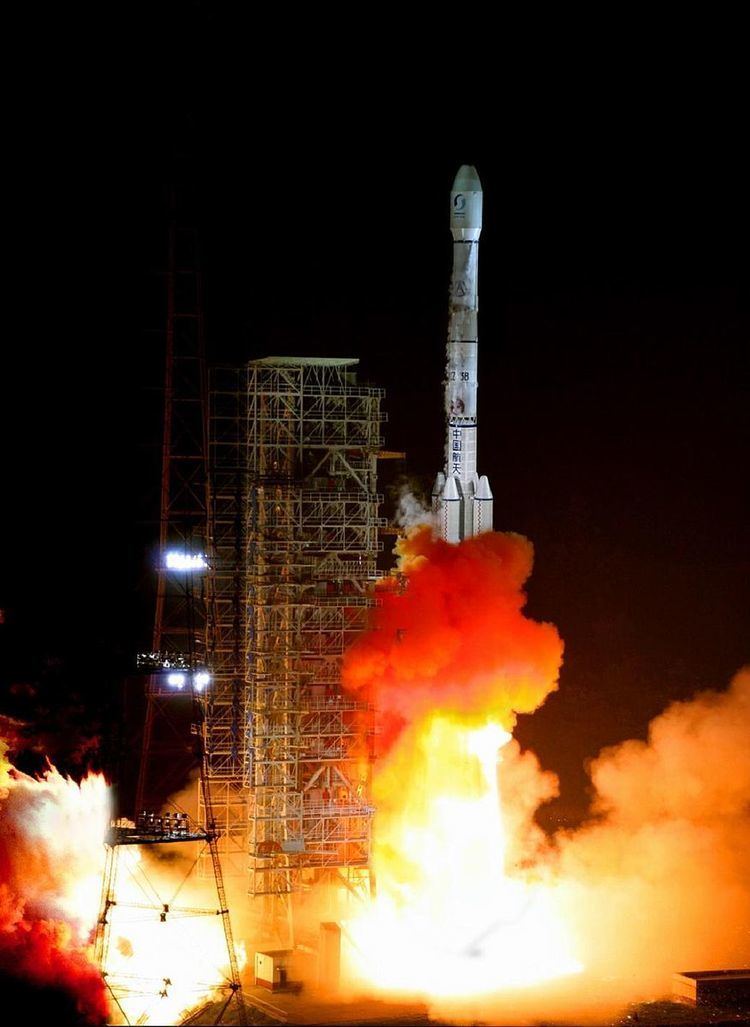Function Carrier rocket | Manufacturer CALT Diameter 3.35 metres (11.0 ft) | |
 | ||
Height 3B: 54.838 metres (179.91 ft)3B/E: 56.326 metres (184.80 ft) Mass 3B: 425,800 kilograms (938,700 lb)3B/E: 458,970 kilograms (1,011,860 lb) | ||
The Long March 3B (Chinese: 长征三号乙火箭, Chang Zheng 3B), also known as the CZ-3B and LM-3B, is a Chinese orbital carrier rocket. Introduced in 1996, it is launched from Launch Area 2 and 3 at the Xichang Satellite Launch Center in Sichuan. A three-stage rocket with four strap-on liquid rocket boosters, it is currently the most powerful member of the Long March rocket family and the heaviest of the Long March 3 rocket family, and is mainly used to place communications satellites into geosynchronous orbits.
Contents
- History
- Design and variants
- Long March 3BE
- Long March 3C
- Intelsat 708 launch failure
- Palapa D partial launch failure
- References
An enhanced version, the Long March 3B/E, was introduced in 2007 to increase the rocket's GTO cargo capacity and lift heavier GEO communications satellites. The Long March 3B also served as the basis for the medium-capacity Long March 3C, which was first launched in 2008. As of December 2016, the Long March 3B and 3B/E have conducted 35 successful launches, plus one failure and one partial failure, giving it a success rate of 7001946000000000000♠94.6%.
History
The development of the Long March 3B began in 1986 to meet the needs of the international GEO communications satellite market. During its maiden flight on 14 February 1996 carrying the Intelsat 708 satellite, the rocket suffered a guidance failure two seconds into the flight and destroyed a nearby town, killing at least six people, but outside estimates suggest that anywhere between 200 and 500 people might have been killed. However, the author of later ruled out large casualties, because evidence suggest that the crash site is evacuated before launching.
The Long March 3B and 3B/E rockets conducted ten successful launches between 1997 and 2008.
In 1997, the Agila 2 satellite was forced to use onboard propellant to reach its correct orbit because of poor injection accuracy on the part of its Long March 3B launch vehicle. In 2009, a Long March 3B partially failed during launch due to a third stage anomaly, which resulted in the Palapa-D satellite reaching a lower orbit than planned. Nonetheless, the satellite was able to maneuver itself into the planned orbit. The Long March 3B and its variants remain in active use as of January 2014, having conducted a total of 23 consecutive successful launches.
In December 2013, a Long March 3B/E successfully lifted Chang'e 3, China's first Lunar lander and rover into the projected lunar-transfer orbit.
Design and variants
The Long March 3B is based on the Long March 3A as its core stage, with four liquid boosters strapped on the first stage. It has an LEO cargo capacity of 12,000 kilograms (26,000 lb) and a GTO capacity is 5,100 kilograms (11,200 lb).
Long March 3B/E
The Long March 3B/E is an enhanced variant of the Long March 3B, featuring an enlarged first stage and boosters, increasing its GTO payload capacity to 5,500 kilograms (12,100 lb). Its maiden flight took place on 13 May 2007, when it successfully launched Nigeria's NigComSat-1, the first African geosynchronous communications satellite. In 2013, it successfully launched China's first lunar lander Chang'e 3 and lunar rover Yutu.
Long March 3C
A modified version of the Long March 3B, the Long March 3C, was developed in the mid-1990s to bridge the gap in payload capacity between the Long March 3B and 3A. It is almost identical to the Long March 3B, but has two boosters instead of four, giving it a reduced GTO payload capacity of 3,800 kilograms (8,400 lb). Its maiden launch took place on 25 April 2008.
Intelsat 708 launch failure
On February 14, 1996, the launch of the first Long March 3B with Intelsat 708 failed just after liftoff when the launch vehicle veered off course and exploded when it hit the ground at T+23 seconds. At least 6 people on the ground were killed by the explosion. The cause of the accident was traced to short-circuiting of the vehicle's guidance platform at liftoff.
Palapa-D partial launch failure
On August 31, 2009, during the launch of Palapa-D, the third stage engine under-performed and placed the satellite into a lower than planned orbit. The satellite was able to make up the performance shortfall using its own engine and reach geosynchronous orbit, but with its lifetime shortened to 10.5 years. Investigation found that the engine’s gas generator suffered a burn-through due to ice blockage in the engine’s liquid-hydrogen injectors.
